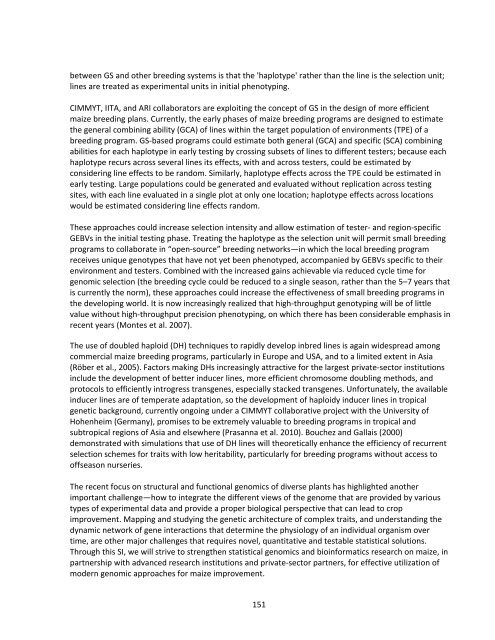Download - Maize
Download - Maize
Download - Maize
You also want an ePaper? Increase the reach of your titles
YUMPU automatically turns print PDFs into web optimized ePapers that Google loves.
etween GS and other breeding systems is that the 'haplotype' rather than the line is the selection unit;<br />
lines are treated as experimental units in initial phenotyping.<br />
CIMMYT, IITA, and ARI collaborators are exploiting the concept of GS in the design of more efficient<br />
maize breeding plans. Currently, the early phases of maize breeding programs are designed to estimate<br />
the general combining ability (GCA) of lines within the target population of environments (TPE) of a<br />
breeding program. GS‐based programs could estimate both general (GCA) and specific (SCA) combining<br />
abilities for each haplotype in early testing by crossing subsets of lines to different testers; because each<br />
haplotype recurs across several lines its effects, with and across testers, could be estimated by<br />
considering line effects to be random. Similarly, haplotype effects across the TPE could be estimated in<br />
early testing. Large populations could be generated and evaluated without replication across testing<br />
sites, with each line evaluated in a single plot at only one location; haplotype effects across locations<br />
would be estimated considering line effects random.<br />
These approaches could increase selection intensity and allow estimation of tester‐ and region‐specific<br />
GEBVs in the initial testing phase. Treating the haplotype as the selection unit will permit small breeding<br />
programs to collaborate in “open‐source” breeding networks—in which the local breeding program<br />
receives unique genotypes that have not yet been phenotyped, accompanied by GEBVs specific to their<br />
environment and testers. Combined with the increased gains achievable via reduced cycle time for<br />
genomic selection (the breeding cycle could be reduced to a single season, rather than the 5–7 years that<br />
is currently the norm), these approaches could increase the effectiveness of small breeding programs in<br />
the developing world. It is now increasingly realized that high‐throughput genotyping will be of little<br />
value without high‐throughput precision phenotyping, on which there has been considerable emphasis in<br />
recent years (Montes et al. 2007).<br />
The use of doubled haploid (DH) techniques to rapidly develop inbred lines is again widespread among<br />
commercial maize breeding programs, particularly in Europe and USA, and to a limited extent in Asia<br />
(Röber et al., 2005). Factors making DHs increasingly attractive for the largest private‐sector institutions<br />
include the development of better inducer lines, more efficient chromosome doubling methods, and<br />
protocols to efficiently introgress transgenes, especially stacked transgenes. Unfortunately, the available<br />
inducer lines are of temperate adaptation, so the development of haploidy inducer lines in tropical<br />
genetic background, currently ongoing under a CIMMYT collaborative project with the University of<br />
Hohenheim (Germany), promises to be extremely valuable to breeding programs in tropical and<br />
subtropical regions of Asia and elsewhere (Prasanna et al. 2010). Bouchez and Gallais (2000)<br />
demonstrated with simulations that use of DH lines will theoretically enhance the efficiency of recurrent<br />
selection schemes for traits with low heritability, particularly for breeding programs without access to<br />
offseason nurseries.<br />
The recent focus on structural and functional genomics of diverse plants has highlighted another<br />
important challenge—how to integrate the different views of the genome that are provided by various<br />
types of experimental data and provide a proper biological perspective that can lead to crop<br />
improvement. Mapping and studying the genetic architecture of complex traits, and understanding the<br />
dynamic network of gene interactions that determine the physiology of an individual organism over<br />
time, are other major challenges that requires novel, quantitative and testable statistical solutions.<br />
Through this SI, we will strive to strengthen statistical genomics and bioinformatics research on maize, in<br />
partnership with advanced research institutions and private‐sector partners, for effective utilization of<br />
modern genomic approaches for maize improvement.<br />
151

















